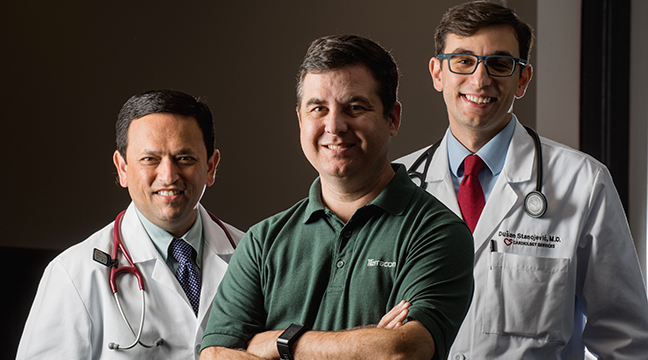(Pictured) Mike Laney is able to enjoy life after a close call with heart disease thanks to his cardiologists Dr. Ashutosh Bapat and Dr. Dusan Stanojevic.
As a geotechnical engineer, Mike Laney of Olathe evaluates soil and other components of the Earth to determine and design foundations for construction sites. If the soil mechanics beneath a structure are unstable, a collapse could become imminent. In 2015, little did Mike know that the mechanics of his own heart health were beginning to shift—resulting in a life-threatening situation.
Mike’s symptoms emerged slowly. At first, he felt more winded during his workouts, and wasn’t seeing the results he expected from time spent at the gym. Eventually, he began to feel more and more tired.
In November 2015, a casual conversation with a colleague may have been the tip that saved Mike’s life.
“I mentioned to my co-worker that I was about to take a ham radio operator’s exam, and she said her late husband had been a ham radio enthusiast,” said Mike. “She went on to tell me that he had died from a sudden heart attack at age 45— the same age as I was at the time.”
Two days later, Mike woke up in a cold, clammy sweat. He was nauseous, his heart was racing and he just didn’t feel “right.”
“I couldn’t get the conversation with my co-worker out of my head, so I headed to the emergency room at OMC,” Mike said.
The ER physicians ran a number of tests, including blood tests, an EKG and a chest X-ray. Although the tests ruled out a heart attack, Mike was referred to cardiologist Ashutosh Bapat, MD, FACC, FASE, with Cardiology Services at OMC.
Dr. Bapat examined Mike, and after a thorough review of his symptoms ordered an exercise stress test with an echocardiogram. This test showed inconclusive findings, but due to the fact that his symptoms were quite concerning and there was no clear alternative explanation, Dr. Bapat ordered a coronary CT angiogram (CCTA). This showed that Mike had a very tight blockage in a major blood vessel.
“His CCTA demonstrated Mike had a 99 percent blockage in his left anterior descending artery (also known as the widow-maker artery),” Dr. Bapat said. “The build-up of plaque was reducing the flow of oxygen and nutrients to his heart, and was the cause of his symptoms. Untreated, this could have led to a heart attack. It was critical that he underwent treatment for this without delay.”
CCTA is a new advancement in the diagnosis of patients with coronary artery disease. It is a very accurate, non-invasive way of visualizing the heart arteries.
“It is an excellent test in clinical situations like Mike’s when the symptoms are concerning, and the more traditional stress test yields negative or inconclusive results,” Dr. Bapat said.
Dr. Bapat then scheduled Mike for a diagnostic cardiac catherization and intervention procedure at Olathe Medical Center’s Cardiovascular Center. When Mike asked to push back the procedure date by a week to accommodate family plans, Dr. Bapat insisted he not delay. Mike agreed.
Dusan A. Stanojevic, MD, of Cardiology Services, performed the cardiac catheterization, in which a thin, hollow catheter was inserted into the blood vessels supplying Mike’s heart. Contrast material injected through the catheter allowed Dr. Stanojevic to use x-ray imaging and visualize the major blood vessels and also the main pumping chamber of the heart. This test confirmed that a severe narrowing was indeed present in the heart artery, and this was the source of Mike’s symptoms.
To open the narrowed artery, Dr. Stanojevic inserted a tiny balloon into the blocked artery and placed a stent to hold the artery open like a scaffold. The stent will remain in Mike’s artery permanently and improves blood flow to the heart muscle.
Mike spent one night in the hospital then returned home. Part of his recovery involved attending cardiac rehabilitation at OMC, which included healthy lifestyle education, a closely monitored exercise program, diet and nutrition counseling, along with plenty of encouragement and support.
“Heart disease was NOT on my radar,” Mike said. “My case was unique since I didn’t have the classic signs or test results, but Dr. Bapat had a gut feeling about it and really advocated on my behalf to get me the care I needed quickly. His expertise saved my life.”
Dr. Bapat encourages everyone to know the risk factors for heart disease and recognize the signs of heart attack.
“People at higher risk include those with high blood pressure, diabetes, high cholesterol, smokers, a very sedentary lifestyle and a family history of heart disease,” Dr. Bapat said. “It’s also so important for patients to know their numbers. Cholesterol, blood pressure, weight and glucose are all things you should be tested for regularly and discuss with your primary care physician. It is also important to stay active and exercise regularly.”
“This was my wake-up call,” Mike said. “But thanks to doctors who listened to me and acted quickly, I’m here and able to enjoy life with my wife and three children.”

